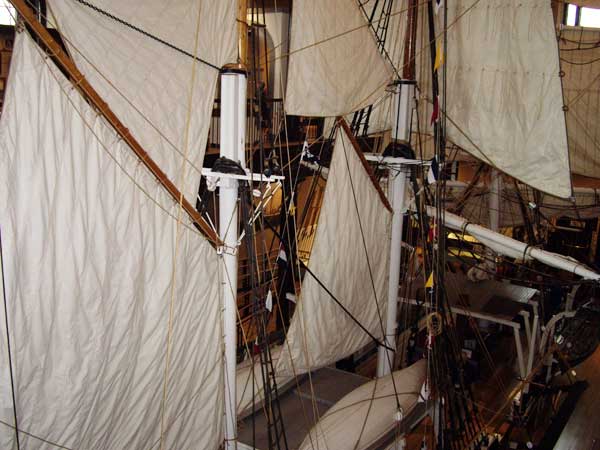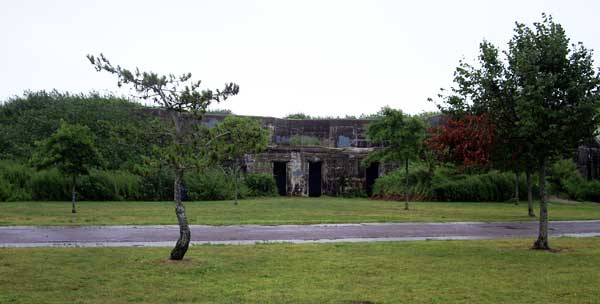
New England (5)
Diagonally opposite the Corson Building is the New Bedford Whaling Museum...

New Bedford Whaling Museum

The museum has a 1/2 size replica of a whaling ship

Everyone knows the whaling cry "Thar she blows" but another that is mentioned a lot is "Chimney's afire". Harpooning a whale didn't kill it but merely fastened the whaling boat to it. The whale would thrash about and take the boat on a "Nantucket Sleighride". Being dragged along by a wounded whale made the whalers of the time the fastest people afloat. Once the whale tired the whalers would lance it, trying to find the "life" of the whale. This is a group of coiled arteries near the animal's heart. When these were pierced blood would be forced out of its blowhole and it was this that caused the cry "Chimney's afire". New Bedford Whaling Museum shows a short film of Portuguese whalers from, I guess, the 1970's and believe me "Chimney's afire" is as bloody as it sounds.
The 1956 film version of of Moby Dick also used real Portuguese whalers when they shot these scenes - http://www.youtube.com/watch?v=0uOAe5e85yM
At the back of a whaleboat is a heavy piece of wood called a loggerhead. A typical whale boat had around 2,000ft of harpoon line and it was wrapped around the loggerhead a couple of times to stop it being paid out too fast. I'm not sure if this is the correct origin of the phrase but someone from the museum said that to "be at loggerheads" over some difficult choice was the choice the mate would have to make if the whale started diving too deep and the boat was in danger of being dragged down with it. The mate could cut the rope on the loggerhead allowing the whale to escape, and perhaps saving the lives of the boat crew but if he did then the whole crew would suffer because they were paid on a lay system. That is, each crew member was paid a lay, or part of the profits from the trip, which could last up to four years.
Some lays were very long at less than 1/300th of the profits, which meant the seaman could be away for 4 years and on his return only get around $15 for his work. In Moby Dick, Bildad, the Pequod's owner, offers Ishmael a 1/777 lay. Uneducated green hands really would often ask for a long lay as they believed the bigger the number the larger the share they'd get! No wonder most whalers only ever made one trip.

A walk
The Walks are a feature of New England coastal houses.
Although it had threatened rain all the time we were in New England this was the only day it actually did, it was still warm though.

New Bedford harbor
After tpuring he museum, which is excellent, we walked around the corner to the Celtic Coffee Shop and had a sandwich. Their sandwiches were great. Before we left New Bedford we took a small trip down to Clarks Point and Fort Taber...

Fort Taber - WWII Merchant Sailors Memorial


Fort Taber
Work on Fort Taber started in 1857 and the first gun was in place in 1863. The Civil War ended in 1865 so the fort was never finished - the planned 3rd floor was never completed. Work completely stopped on the fort in 1871. Left-over granite blocks were used as sea defenses and these can still be seen on the shore. The lighthouse on top of the fort replaced a "proper" lighthouse that had stood there since 1797. The fort blocked light from that lighthouse and a new one was built on top of the fort in 1869.

Battery Walcott
This is just to the east of Fort Taber and was completed in 1899

Patty on the pier at Fort Taber
In the background can be seen Butler Flats Light
This page created 18th August 2011, last modified 7th September 2011